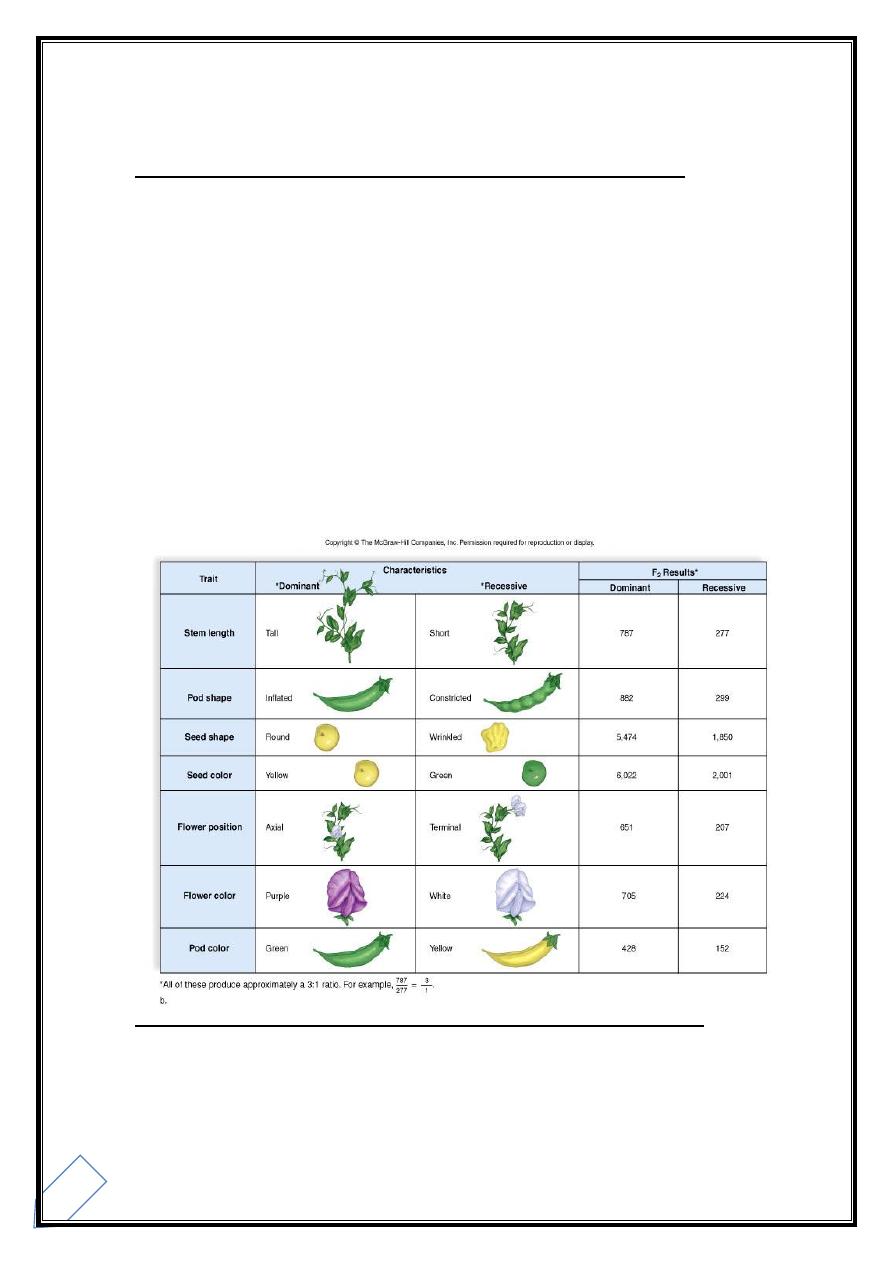
Thi- Qar university Human genetic
Medical college Lect. 1
Microbiology department Dr Dhafer A. ALGHEZI
1
Introduction to Genetics
:
of genetic
ory
Hist
The history of genetics (Modern genetics) began with the work of the
Augustinian friar Gregor Johann Mendel. His work on pea plants, published in
1866, described what came to be known as Mendelian Inheritance.
In 1902, Walter Sutton and Theodore Boveri, using dyes synthesized by the
German organic chemistry industry, observed that "colored bodies" in cells
behaved in ways parallel to the hypothetical agents of heredity proposed by
Mendel. These bodies were called chromosomes.
In 1905, Nettie Stevens observed in Tenebrio beetles that all pairs of
homologous chromosomes are the same size, except for one pair which
determines sex (X & Y).
In 1944, Oswald Avery identified DNA as the genetic material. Pieces of
DNA can transfer genes into bacteria cells, and transform them genetically.
In 1953, Rosalind Franklin and Maurice Wilkins showed that DNA is a double
helix.
In 1970, Temin and Balitimore discovered reverse transcriptase in
retroviruses; an enzyme later used to clone genes based on the RNA encoding
the product.
In 1987, Kary Mullis invented the polymerase chain reaction (PCR), using a
thermostable enzyme from a thermophilic bacterium discovered by Thomas
Brock at a geyser in Yellowstone.
The first bacterial genome sequence, Haemophilus influenzae, was completely
determined in 1995.
In 1996, Ian Wilmut cloned the lamb Dolly from adult mammary gland tissue.
In 2000, Completion of the human genome.
Genetic terminology:
Genetic:
is a branch of biology concerned with the study of genes, genetic variation,
and heredity in organisms.
Genome
is the complete set of instructions for making an organism. It contains the
master blueprint for all cellular structures and activities for the lifetime of the cell or
organism
Heredity (also called inheritance or biological inheritance), is the passing on of traits
from parents to their offspring; either through asexual reproduction or sexual
reproduction, the offspring cells or organisms acquire the genetic information of their
parents.
Offspring is another name for the children of a male and female parent.

Thi- Qar university Human genetic
Medical college Lect. 1
Microbiology department Dr Dhafer A. ALGHEZI
2
Traits are specific characteristics that vary from one individual to another such as ear
lobe attachment, brow line, or chin type.
Genes are small sections of DNA that code for a specific trait, their coded
information determines the nature and development of organisms the code is the order
of the bases (letters). The human genome is estimated to comprise more than 25,000
genes.
Genotype is the genetic makeup of an organism, a description of the genes it contains
e. g: AA or Aa or aa.
Phenotype is the characteristics that can be observed in an organism, for example red
hair or brown hair. Phenotype is determined by interaction of genes and environment
Allele is a different form of a particular gene, positioned in the same relative place
(locus) on a homologous chromosome. Each allele is represented by a letter.
Chromosomes: bundles of DNA that make up your genome, where genes are
located. The 3 billion bp in the human genome are organized into 24 distinct
physically separate chromosomes. All genes are arranged linearly along the
chromosomes. The nucleus of most human cells contains two sets of chromosomes, 1
set given by each parent. Each set has 23 single chromosomes; 22 autosomes and a
sex chromosome (X or Y).
Dominant and Recessive Genes: Two alleles are inherited for each gene in simple
single trait crosses:
Pure dominant - an organism with two dominant genes
Pure recessive - an organism with two recessive genes
Homozygous: having two identical alleles for a trait. Also called Purebred.
Heterozygous: have two different alleles for a trait.
The organism has one
dominant
and
one
recessive
gene.
The
dominant
gene
shows, the recessive trait is hidden. Also called hybrid.
Monohybrid crosses: which are mating between individuals that differ in only on
the trait, or the tracking of the inheritance of a single trait.
Dihybrid cross: cross between parents that are heterozygous for 2 traits.
True breeding is a term used to describe organisms that produce offspring identical
to them if allowed to self-pollinate. True-breeding means there is no new genetic
material being introduced into the offspring.
Self-pollination: the pollen and egg are derived from the same plant

Thi- Qar university Human genetic
Medical college Lect. 1
Microbiology department Dr Dhafer A. ALGHEZI
3
Cross pollination: the transfer of pollen from the anther of a flower to the stigma of a
flower on a different plant.
Cross pollination produces offspring that are different
from their parents and each other.
Blending theory of heredity:
Pre-Mendelian theory of heredity proposing that hereditary material from each
parent mixes in the offspring; once blended like two liquids in a solution, the
hereditary material is inseparable in the offspring
Individuals of a population should reach a uniform appearance after many
generations
Once traits blended, they cannot be separated out to appear again in later
generations.
Particulate theory of heredity
states that discrete "particles" (now referred to as genes) are passed from parents to
offspring. the character of the offspring is not a smooth blend of essences from the
parents. Mendel also knew that particles may not be present in every generation, but
they remain and keep their ability to be expressed in later generations. For example,
perhaps one of your parents has blue eyes and the other brown eyes. You yourself
have brown eyes but you keep the gene for blue eyes, which can be expressed in your
offspring if you mate with someone who also carries the gene for blue eyes.
Introduction to Gregor mendel:
known as the father of Genetics
Augustinian monk
Studied at University of Vienna from 1851-1853
Mendel used a quantitative approach to his experimentation.
Discovered principles of genetics.
Explained some basic laws of genetics.
Mendel chose pea plant as his experimental organisms:
Mendel study of genetics grew out of his interest in ornamental flowers. Prior to
his work with pea plants, many plant breeders had conducted experiment aimed at
obtaining flowers with new varieties of colors. When two distinct individuals with
different characteristic are mated (or crossed) to each other, this called a hybridization
experimented and offspring are referred to as Hybrid.
The parental plants are called the parental (P) generation. Their hybrid
offspring represent the next generation called the first filial (F1) generation. Mendel
allowed the F1 generation to self-fertilize to produce the next generation called the
second filial (F2) generation

Thi- Qar university Human genetic
Medical college Lect. 1
Microbiology department Dr Dhafer A. ALGHEZI
4
Mendel’s work is an elegant model of experimental design and analysis!
He provided a remarkable insight into the methodology necessary for good
experimental biology. The essential components of his research are:
He chose the garden pea (Pisum sativum) due its ideal characteristics:
A: easy to grow-interbreed
B: self-fertilizing
C: easily crossbred in designed experiments
D: reproduces well and mature in a single season.
1. He worked with seven-unit characters. These are visible features that were
each represented by two contrasting traits Figure 1.
2. He established TRUE-BREEDING varieties in which the seeds were
available from local seed merchant.
Factors that contributed to Mendel’s success in an area where other failed:
1. Choice of suitable organism.
2. Restricted his experiments to one or few pairs of contrasting traits
3. Kept accurate quantitative records.

Thi- Qar university Human genetic
Medical college Lect. 1
Microbiology department Dr Dhafer A. ALGHEZI
5
Mendel laws of inheritance
Mendel postulated three laws, which are now called
after his name as Mendel’s laws
of heredity. These are:
A.
Law of Dominance:
When two homozygous individuals with one or more
sets of contrasting characters are crossed, the characters that appear in the
F1 hybrids are dominant characters and those do not appear in F1 are
recessive characters.
B.
Mendel’s law of segregation: Allele pairs segregate during gamete formation
(meiosis) and the paired condition is restored by the random fusion of gametes
at fertilization.
1. Each trait has two genes, one from the mother and one from the father.
2. Traits can be either dominant or recessive.
3. A dominant trait only needs one gene in order to be expressed.
4. A recessive trait needs two genes in order to be expressed
5. Egg and sperm are sex cells called gametes.
6. Segregation is the separation of alleles during gamete formation.
C.
Law of Independent Assortment: The genes for different traits are inherited
independently of each other. (when two or more characteristics are inherited,
individual hereditary factors assort independently during gamete production,
giving different traits an equal opportunity of occurring together).

Thi- Qar university Human genetic
Medical college Lect. 1
Microbiology department Dr Dhafer A. ALGHEZI
6
Mendel Did A Dihybrid cross:
Mendel performed a second series of cross that are called dihybrid crosses
because the offspring are dihybrid, they are product of two different strains
that differ in regard to two traits. For example, he crossed tall plant having
green pods with short plants having yellow pods. The F1 plants showed both
dominant characteristics. as before. Mendel then allowed the F1 plants to self
pollinate. Two possible results could occur in F2 generations:
1. If the dominant factor (TG) always segregations into the gametes together. And
the recessive factors (tg). Then there would be two phenotypes among the F2
plants, tall plants with green pods and short plants with yellow pods.
2. If the four factors segregate into the gametes independently. Then there would be
four phenotypes among the F2 plants, tall plants with green pods, tall plants with
yellow pods, Short plants with green pods, and short plants with yellow pods.
Mendel’s Hypothesis:
1: Alternative forms of genes are responsible for variations in inherited characters
(alternative forms are now called alleles)
2: For each character, an organism inherits two alleles, one from each parent
3: If the two alleles differ, one is fully expressed (dominant allele) whereas, the other
is completely masked (recessive allele)
4: The two alleles from each character segregate during gamete production.
